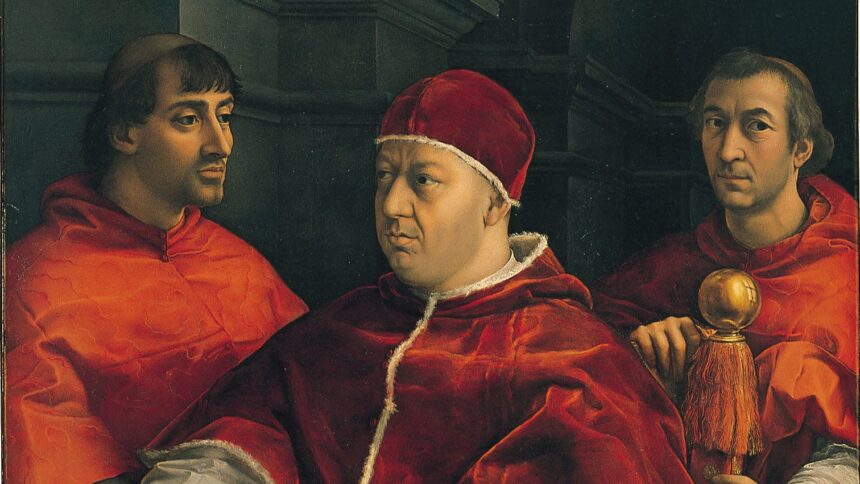Cosimo de’ Medici (Cosimo the Elder): Founder of the Medici Dynasty
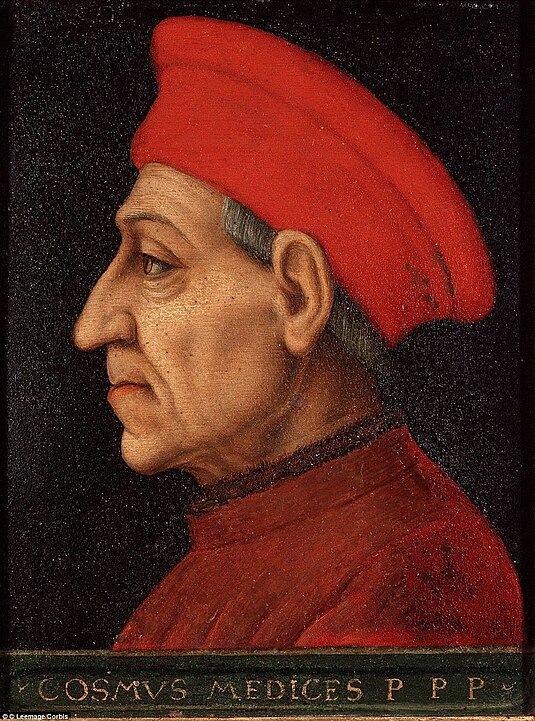
Cosimo de’ Medici, known as Cosimo the Elder (1389–1464), was the founder of the Medici dynasty and one of the most influential figures in the 15th-century Florence. A banker and statesman, Cosimo was also a patron of the arts, using his wealth to shape both the political and cultural landscape of the city.
- Cosimo de’ Medici (Cosimo the Elder): Founder of the Medici Dynasty
- Ferdinando I de’ Medici: A Model of Kindness and Tolerance
- Cosimo I: The Turning Point for the Medici Dynasty
- Leo X: The Medici Pope and Patron of the Arts
- Lorenzo de’ Medici (1449–1492): The Magnificent Ruler of Florence
- Marie de’ Medici (1575–1642): Queen of France and Regnant Mother
- Catherine de’ Medici: A Key Figure of the French Renaissance
- Piero di Lorenzo de’ Medici: The Tragic Reign of Piero the Unfortunate
- Gian Gastone de’ Medici: The Final Heir of the Medici Dynasty
Rise to Power
In 15th-century Florence, where a well-filled purse often held more value than noble lineage, Cosimo knew how to use his considerable fortune to gain control. He was the son of Giovanni di Bicci, who founded the Medici Bank, and after his father’s death in 1429, Cosimo inherited the family business, expanding it by establishing banking branches in Geneva, Bruges, and Rome. By the time of his father’s passing, he was the wealthiest man in Florence.
Cosimo used his vast fortune for his political ambitions, employing clientelism on a grand scale.
He bought alliances, paid his supporters, and used his wealth to secure high political offices. His popularity among the popolo minuto (the common people), especially artisans, was key to his dominance in Florence. Cosimo generously funded the poor, constructed hospitals, and organized grand celebrations, presenting himself as a benefactor of the people.
This image helped him secure uncontested control over the city.
Exile and Return
On September 7, 1433, Cosimo was arrested by Rinaldo degli Albizzi, leader of the aristocracy, and sentenced to death. However, Cosimo managed to bribe the justice system, having his sentence commuted to exile. He moved to Venice, where he continued to influence Florentine politics from afar.
In 1434, supporters of Cosimo were elected to key positions in government, and he was recalled to Florence. He became the gonfaloniere (chief magistrate) and exacted revenge by exiling those responsible for his initial banishment.
Establishing Power and Legacy
Though presenting himself as a champion of democracy—earning the title of Pater Patriae (Father of the Fatherland)—Cosimo subtly altered the political structure of Florence. He created a Senate filled with his supporters and centralized power in his hands by reforming institutional procedures. These changes solidified the Medici family’s control over Florence, paving the way for their two-century rule over the city and beyond.
Cosimo’s political and financial strategies laid the foundation for the Medici dynasty, ensuring its influence in both Florence and the broader Italian Renaissance.
Ferdinando I de’ Medici: A Model of Kindness and Tolerance

Cardinal-turned-Grand Duke of Tuscany, Ferdinando I (1549–1609) was known for his gentle and tolerant rule—the polar opposite of his unpopular elder brother, Francesco I, whom he succeeded.
Born as the eighth of nine children of Cosimo I and Princess Eleanor of Toledo, Ferdinando was not initially destined to rule. Instead, like many younger sons of noble families, he was set on a religious career. At just 14 years old, in 1562, he was appointed cardinal in Rome, where he acquired a palace to house his art collection—a building later known as Villa Medici (now home to French artists in Rome).
However, fate took a different course. In 1587, his elder brother, Grand Duke Francesco I, died under mysterious circumstances—possibly poisoned. With Francesco’s sudden death, Ferdinando assumed power in Florence and ruled in stark contrast to his predecessor. Whereas Francesco governed as a tyrant, persecuting opponents and imposing heavy taxes—especially on grain—Ferdinando won the people’s affection by ruling with fairness and moderation. He also restored a judicial system that had suffered under his ancestors.
A Champion of Religious Tolerance
In 1591, Ferdinand enacted the Leggi Livornine, a set of laws that granted the Tuscan port city of Livorno free port status. This exempted merchants from taxes regardless of their nationality, but more importantly, it ensured complete religious freedom. The city became a safe haven for Greeks, Dutch traders, Turks, and Portuguese Jews fleeing the Catholic Reconquista in Iberia, creating a diverse and multi-religious community—a testament to Ferdinand’s tolerance.
Family and Succession
In 1589, two years after becoming Grand Duke, Ferdinand officially renounced his position as cardinal for dynastic reasons. This allowed him to marry Princess Christine of Lorraine, with whom he had eight children. His eldest son, Cosimo II, succeeded him as Grand Duke of Tuscany.
Cosimo I: The Turning Point for the Medici Dynasty
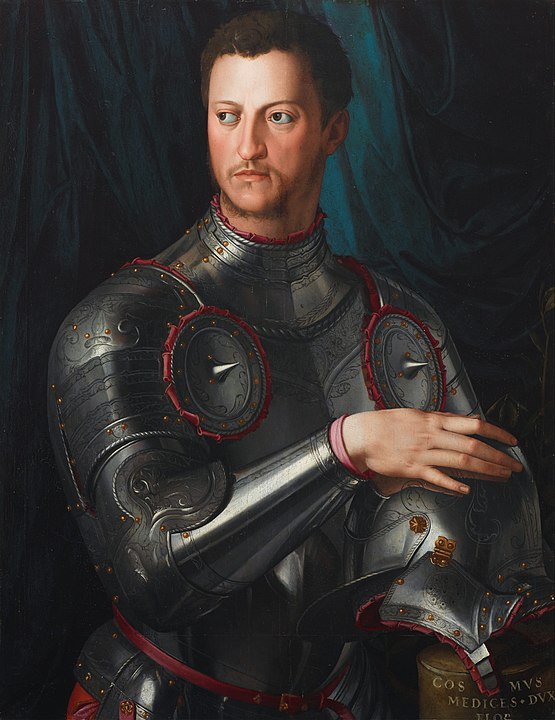
The reign of Cosimo I marked a major turning point for the Medici family: for the first time, the cadet branch of the dynasty rose to power. Elected Duke of Florence at just 18, he later became the first Grand Duke of Tuscany, a title he held until his death. Florence owes him numerous architectural and artistic enhancements, including the creation of the Uffizi Gallery and the Boboli Gardens.
Rise to Power
Cosimo was the son of the condottiero (mercenary leader) Giovanni delle Bande Nere and a direct descendant of the younger brother of Cosimo the Elder—a lineage that had previously stayed away from politics. However, on February 28, 1537, the assassination of Duke Alessandro de’ Medici—a brutal ruler—by his cousin Lorenzo de’ Medici changed everything. Cosimo was elected leader of Florence at just 18, with the blessing of Emperor Charles V, who granted him the right to bear the title Duke of Florence.
To consolidate his power, Cosimo ruled with ruthless repression, exiling or executing his political rivals, including the influential Strozzi and Albizzi families. According to historian Pierre Milza, Cosimo transformed the Republic of Florence into a miniature monarchy, becoming the first Medici to add a regnal number to his name—Cosimo I—like a king.
Military Expansion and the Annexation of Siena
On April 17, 1555, after two years of war and a brutal siege, Cosimo’s forces captured Siena, Florence’s longtime rival. As a reward, Emperor Charles V granted him sovereignty over the city. This conquest was the final military triumph of a ruler who doubled his territory through warfare and who enjoyed being portrayed as a soldier, as seen in contemporary portraits.
Legacy: Architecture and the Grand Duchy
Although Cosimo I was less of a patron of the arts than his Medici predecessors, he left a lasting impact on Florence’s architecture. His most notable contributions include the Uffizi Gallery, originally designed as government offices, and the Boboli Gardens, a masterpiece of landscape design.
In 1569, Pope Pius V granted him the title of Grand Duke of Tuscany, which would be held by his descendants for two centuries. This cemented the transfer of power to the cadet branch of the Medici family, ensuring their dominance over Tuscany.
Leo X: The Medici Pope and Patron of the Arts
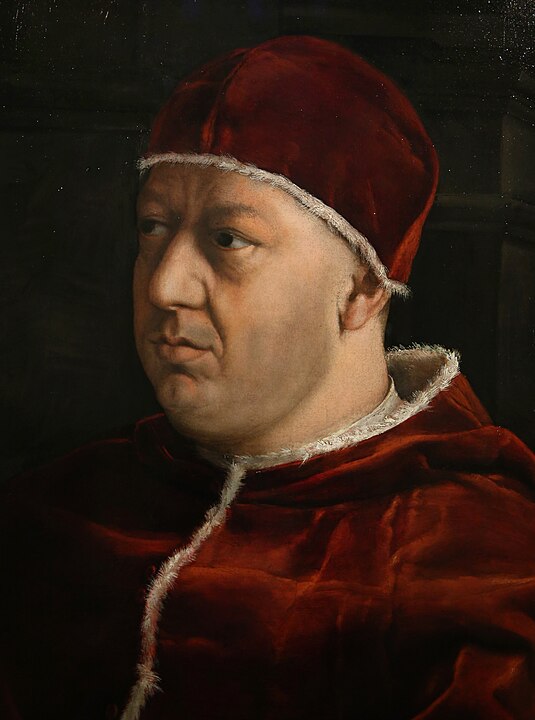
Abbot, cardinal, and later pope under the name Leo X, Giovanni de’ Medici (1475–1521), the younger son of Lorenzo the Magnificent, became one of the greatest patrons of the arts, especially supporting the painter Raphael.
A Predestined Clerical Career
As the younger son of Lorenzo the Magnificent, Giovanni’s destiny was far more glorious than that of his elder brother, Piero the Unfortunate, since he became Pope Leo X at the age of 37. From childhood, the Medici family had destined him for a career in the Church. Leveraging their influence, they secured for him the position of Abbot of Monte Cassino at the age of 12, followed by his appointment as a cardinal at just 13.
Even during the Medici exile from Florence, Giovanni continued his ecclesiastical rise, ultimately winning the papal election in March 1513 and adopting the name Leo X. Like his predecessor, Julius II, he was more concerned with the artistic prestige of the Holy See than theological debates, as he had no formal theological training.
Patronage and the Sale of Indulgences
Leo X devoted vast resources to supporting artists and architects, particularly Raphael. To finance these lavish projects, he promoted the sale of indulgences, a controversial practice that allowed the faithful to pay for absolution of their sins. This system was strongly criticized by Martin Luther, becoming one of the catalysts of the Protestant Reformation. In response, just before his death in 1521, Leo X excommunicated Luther, setting the stage for the Protestant schism.
Political Struggles and Captivity
On April 11, 1512, while still a cardinal, Giovanni de’ Medici was captured at the Battle of Ravenna, where Pope Julius II’s forces clashed with the French army. Taken prisoner by King Louis XII of France, he managed to smuggle vital intelligence about the French military to the Vatican before escaping to Mantua, where he found refuge with Medici allies.
A Weakened Papacy
During Leo X’s pontificate, significant challenges emerged:
- The rise of reformist movements, particularly Lutheranism.
- The Concordat of Bologna (1516), which recognized the French king’s authority over the Catholic Church in France, thereby diminishing papal power.
Despite these setbacks, the Medici influence endured. In 1523, another Medici ascended to the papacy as Clement VII, further securing the family’s legacy within the Vatican.
Lorenzo de’ Medici (1449–1492): The Magnificent Ruler of Florence
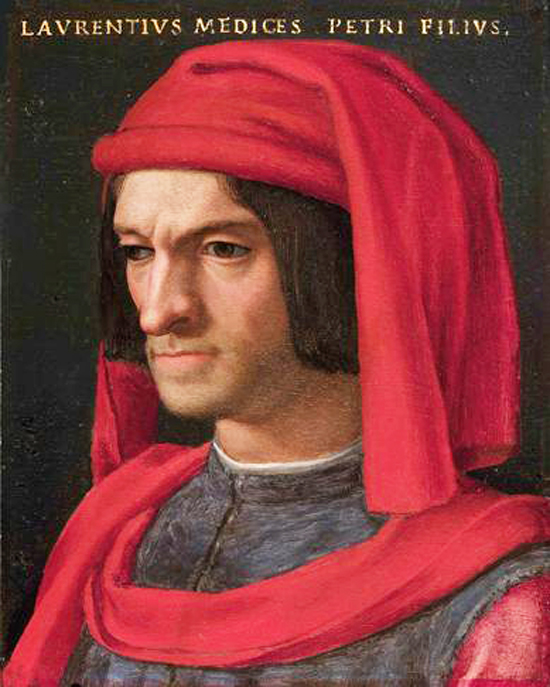
Lorenzo de’ Medici, also known as Lorenzo the Magnificent, governed the Republic of Florence for nearly a quarter of a century and became one of the most remarkable figures of his time. Under his rule, the city of Florence reached its golden age.
Firm Rule and Artistic Patronage
As the grandson of Cosimo de’ Medici, Laurent ruled Florence with a firm hand, but his leadership was tempered by a great love for the arts. He was educated by some of the greatest thinkers of his era, notably the humanist Marsilio Ficino, and became a major patron of the Neoplatonic Academy, which sought to reconcile the teachings of Greek philosophy with Christian principles.
Laurent spent a significant portion of the Medici family fortune to support promising artists, including Botticelli, Leonardo da Vinci, and Michelangelo, helping to cement Florence’s status as the artistic capital of Europe. His enlightened spirit, however, was paired with a ruthless and brutal approach to governance. After succeeding his father Piero the Gouty in 1469, Laurent executed forty of his opponents and exiled their families. He also reformed the communal institutions to bolster his power, establishing a Council of seventy members, all loyal to the Medici family, to control decision-making and conduct political trials.
The Pazzi Conspiracy
The Pazzi family, angered by the Medici’s arbitrary confiscation of part of their fortune, conspired against Laurent, with the backing of Pope Sixtus IV. On April 26, 1478, while Laurent was attending mass in the Florence Cathedral, the conspirators struck. They murdered his brother, Giuliano, but failed to kill Laurent, who was only wounded in the attack. Upon learning of the assassination attempt, the people of Florence carried out a three-day manhunt, capturing and executing the conspirators, many of whom were hung from windows or thrown into the Arno River.
Cultural Legacy and Financial Strain
Though Laurent’s patronage drained the Medici resources, it gave Florence an unmatched cultural prestige, making it a center for art and learning in Europe. His reign, marked by political cunning and artistic flourishing, remains one of the most defining periods in the history of the Medici family and the Renaissance.
Marie de’ Medici (1575–1642): Queen of France and Regnant Mother
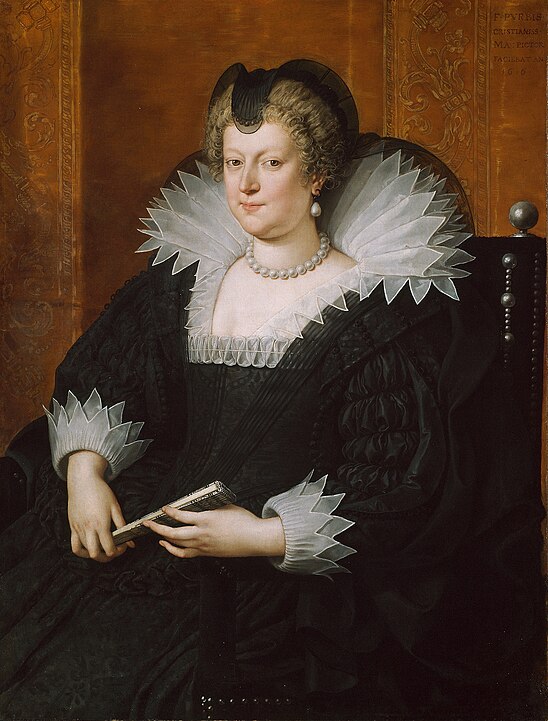
Marie de’ Medici, born in 1575, became Queen of France through her marriage to King Henry IV, and later served as regent for her son, Louis XIII, after Henry’s assassination.
A Noble Marriage and Royal Ascendancy
The sixth daughter of Francesco I de’ Medici, Grand Duke of Tuscany, and Joanna of Austria, daughter of Ferdinand I of Habsburg, Emperor of the Holy Roman Empire, Marie was considered an excellent match due to both her imperial lineage and the vast fortune of the Medici family. Following her father’s poisoning death in 1587, her uncle Ferdinand de’ Medici capitalized on this situation, arranging her marriage to Henry IV of France in 1600 with a dowry of 600,000 gold écus. Despite being referred to as the “big banker” by her rivals, Marie contributed not only her wealth but also gave Henry six children in nine years, including the future Louis XIII.
Regency and Conflict
Marie was crowned queen of France on May 13, 1610, but the very next day, Henry IV was assassinated by François Ravaillac. As a result, the new queen assumed the role of regent for her young son, who was only eight years old at the time. Marie, continuing the Medici family tradition of supporting the arts, contributed to the cultural development of France. However, her pro-Spanish politics and her status as an “outsider”—often accused of favoring Italian courtiers—led to opposition from French nobles, notably the Prince of Condé, who rebelled against her authority.
Exile and Fall from Power
Her strained relationship with her son Louis XIII culminated in her exile on April 24, 1617, when he forced her out of power. Over the years, she reconciled with Louis XIII in 1621 and attempted to regain her political influence by plotting against her old enemy, Cardinal Richelieu. However, Louis XIII renewed his support for Richelieu during the “Day of the Dupes” on November 12, 1630, further disgracing his mother.
In the final years of her life, Marie sought refuge in Cologne, at the home of her friend, the painter Peter Paul Rubens, and died in poverty in 1642. Despite her tumultuous reign, Marie de’ Medici remains a significant figure in French history, symbolizing both the strength and fragility of a royal mother’s power.
Catherine de’ Medici: A Key Figure of the French Renaissance
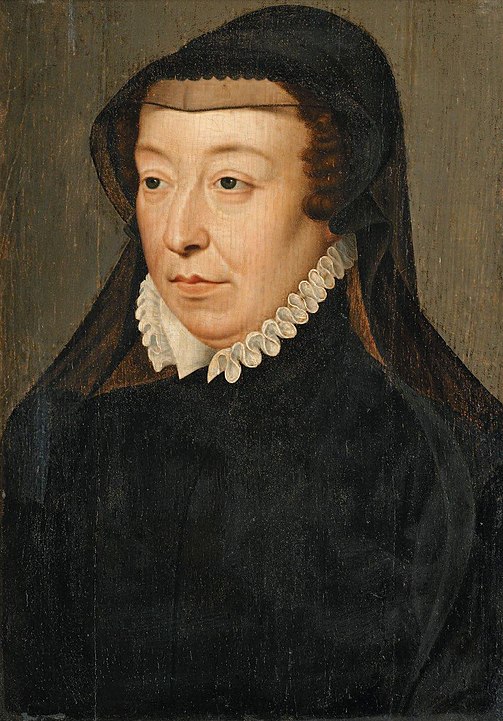
Early Life and Origins
Catherine de’ Medici, born Caterina Maria Romola di Lorenzo de’ Medici on April 13, 1519, in Florence, was a daughter of Laurent II de’ Medici and Madeleine de la Tour d’Auvergne. After her mother’s death shortly after her birth, Catherine was raised under the protection of her powerful family, the Medici, and the influential Pope Clement VII, her cousin. Amid the Republican revolt in Florence, she was briefly taken hostage, but was later freed by the forces of the Holy Roman Empire.
Marriage to Henry II
In 1533, Catherine married Henry, Duke of Orléans, the second son of Francis I of France. Although Henri was not initially expected to rule, as he had an elder brother, Francis III of Brittany, his marriage to Catherine brought the Medici family closer to the French crown and the Pope. The marriage, celebrated on October 28, 1533, was politically motivated and included a significant dowry. Upon the death of his brother, Henri became the Dauphin of France, and later ascended the throne as Henry II in 1547.
Together, Henri II and Catherine de’ Medici had ten children, three of whom became kings of France: Francis II, Charles IX, and Henry III.
Regency and Political Influence
After the death of Francis II in 1560, Catherine became the regent for her son Charles IX, who was too young to rule. During Charles IX’s reign, she played a significant role in French politics, especially navigating the tensions between Catholics and Protestants. Her role as a diplomat intensified during her son Henry III’s reign, which began in 1574, as she attempted to manage internal conflicts and power struggles, including the Duke of Guise rebellion.
Her power began to wane as Henri III grew more independent, culminating in the assassination of the Duke of Guise in 1588 by Henry III. Catherine’s health began to deteriorate after a cold she caught in the same year, and she died on January 5, 1589, from pleurisy at Blois, at the age of 69.
Her Relationship to Francis I
Catherine de’ Medici was the daughter-in-law of Francis I, as she married his son Henry II in 1533. Henri, though not initially a likely candidate for the throne, became the Dauphin after the death of his older brother, Francis III of Brittany. This change in succession ultimately led Catherine to become Dauphine of France and the queen consort when Henri ascended the throne.
Catherine de’ Medici’ legacy is marked by her significant influence over the French monarchy during one of its most turbulent periods, with her leadership shaping the course of French politics, both during her husband’s reign and throughout the regencies of her sons.
Piero di Lorenzo de’ Medici: The Tragic Reign of Piero the Unfortunate
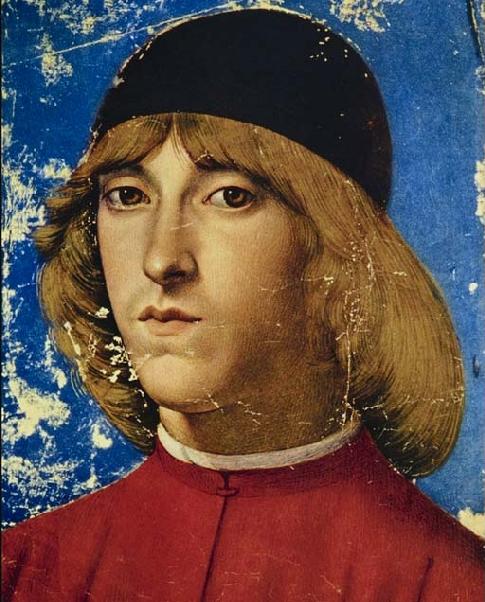
Early Life and Rise to Power
Born in 1472, Piero di Lorenzo de’ Medici was the son of Laurent the Magnificent, and he ascended to power at a very young age following his father’s death in 1492. At just 20 years old, he inherited the leadership of the Medici family and the control of Florence, a position that had been held by his family for nearly six decades.
However, Piero was far from prepared for the responsibilities that came with such power. Lacking the political astuteness of his ancestors, his rule proved disastrous for the family and for the city of Florence.
A Series of Political Failures
Piero quickly found himself out of his depth, making a series of diplomatic blunders. He became embroiled in conflicts, including a quarrel with Ludovico Sforza, the powerful ruler of Milan, and his actions led to the breakdown of the defensive league that had united several Italian states against foreign invasion. His lack of experience and foresight contributed significantly to the unraveling of the Medicis’ influence in Florence.
In 1494, the situation worsened when King Charles VIII of France invaded Italy. Piero, overwhelmed by the approaching threat, capitulated without resistance, surrendering Florence to the French. His humiliating surrender was a turning point that sparked rebellions among the Florentine people, leading to the ousting of the Médicis family.
Exile and the Failure to Return
After the Medicis’ expulsion, Piero did not give up hope of regaining control of Florence. In 1497, he raised a small army of 1,000 men and attempted to reclaim the city. However, his plan was thwarted by a torrential downpour, which delayed his troops and gave the city’s defenders time to prepare. His failed attempt ended in disaster—Piero never returned to Florence and was ultimately drowned while fleeing a battlefield far from home.
Legacy and the Rise of Savonarola
Piero’s departure left a void in Florence, and the power vacuum was soon filled by the Dominican friar Girolamo Savonarola, who established a theocratic regime in Florence. His influence lasted from 1494 to 1498, and he created a deeply religious atmosphere in the city, though his rule was eventually overthrown.
The Medicis’ return to power came in 1512 when Piero di Lorenzo de’ Medici, more capable than his father, was able to restore the family’s authority over Florence, marking the beginning of a new chapter for the Medici dynasty. Piero di Lorenzo de’ Medici’ tragic reign and his failure to navigate the complex political landscape of Renaissance Italy ultimately paved the way for the temporary loss of Medici control, but it also set the stage for the eventual restoration of the family’s power two decades later.
Gian Gastone de’ Medici: The Final Heir of the Medici Dynasty
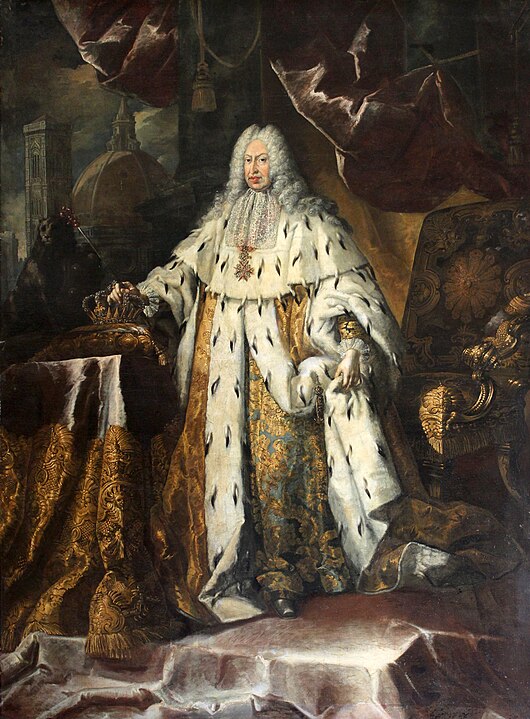
Early Life and Ascension to Power
Born in 1671, Gian Gastone de’ Medici was the great-grandson of Ferdinand I, the first Grand Duke of Tuscany, and the last member of the Medici family to rule over Florence. He ascended to the title of Grand Duke of Tuscany in 1723, at the age of 52, during a period when the political and economic power of Florence had greatly declined. With neither the wealth nor the political clout of his ancestors, Gian Gastone found himself at the head of a city-state in decline, increasingly subjected to the influence of larger European powers.
A Passion for Botany
Unlike his predecessors, who were known for their political acumen and patronage of the arts, Gian Gastone had a keen interest in botany. He cared more for his botanical pursuits than for the political affairs of his realm. One of his significant contributions to Florence was the creation of a garden of rare species within the Boboli Gardens, one of the most iconic parks in the city. His reign, therefore, stood in stark contrast to the political dynastic struggles of his ancestors, marked more by cultural patronage than by political ambition.
Decline of the Medici Dynasty
Despite Gian Gastone’s personal qualities — intelligent, reasonable, and kind — his reign coincided with Tuscany’s political decline. Florence, now a relatively powerless state, became the subject of larger European power struggles. Historians, such as Marcel Brion, have noted that Gian Gastone ruled over a Tuscany that had become more of a pawn than an independent entity on the political stage, with external forces manipulating its future according to their own interests.
The End of the Medici Dynasty
In October 1735, the struggle for control of Tuscany came to a head. Negotiations between the Kingdom of France and the Austrian Archduchy led to an agreement that would bring Tuscany under the control of the House of Habsburg-Lorraine. In exchange for Tuscany, Austria gave up its territories in Lorraine. Despite Gian Gastone’s protests, he was too ill and politically isolated to prevent this transaction from taking place. He died on July 9, 1737, without leaving any heirs, effectively marking the end of the Medici dynasty.
The Habsburg-Lorraine Takeover
After Gian Gastone’s death, the Habsburg-Lorraine family took control of Florence and the Grand Duchy of Tuscany. Francis III of Lorraine, later known as Francis II, assumed the throne, marking the beginning of the Habsburg-Lorraine dynasty’s rule in Tuscany. With this transition, the Medici family, which had held political power in Florence for nearly three centuries, vanished from the scene. The Medici legacy, though, continued in the realms of art, culture, and architecture, even as the family’s direct political influence ended.


